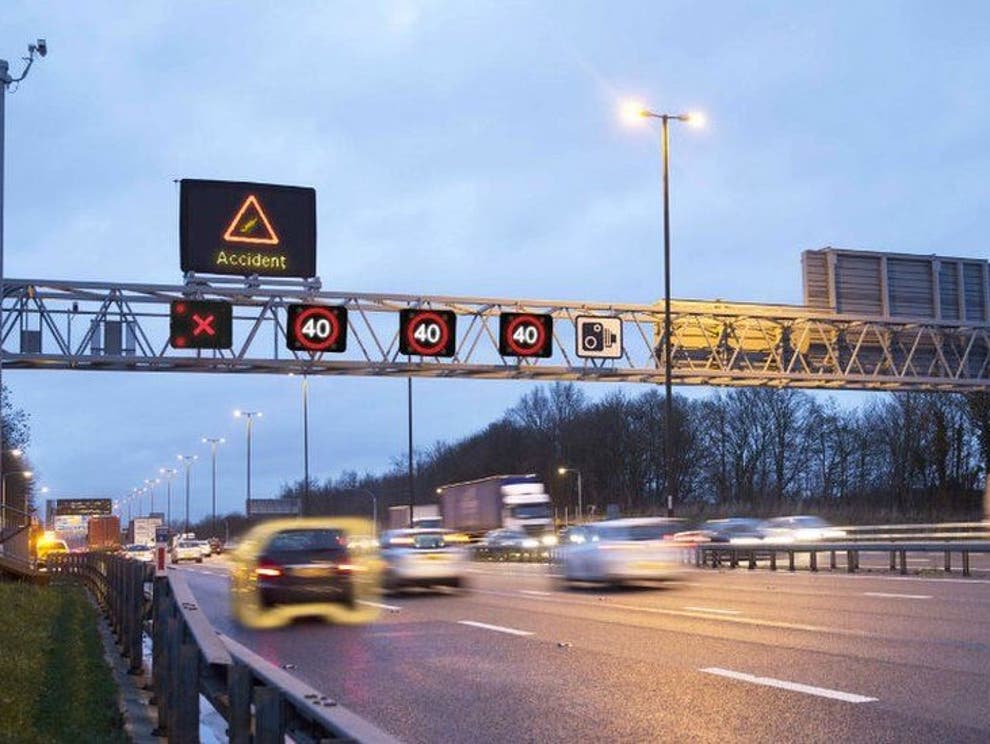Government suspends smart motorway rollout amid safety concerns
Decision follows long campaign from relatives of those killed on roads

The rollout of smart motorways is being put on hold because of safety concerns, the government has announced.
The Department for Transport said it would halt the rollout of new all-lane-running smart motorways, where the hard shoulder is used as a permanent live traffic lane, until it had collected five years of safety data for such schemes introduced before 2020.
The decision follows a recommendation by the Commons Transport Select Committee, which said there was not enough safety and economic data to justify continuing with the project.
In a report in November, the committee described the government’s decision, made in March 2020, to make all future smart motorways all-lane-running as “premature”.
Concerns have been raised following fatal crashes involving broken-down vehicles being hit from behind, and the decision follows a long campaign from relatives of those killed.

In one protest last year, demonstrators carried 38 cardboard coffins to the Department for Transport’s headquarters in London, each representing someone killed on a smart motorway between 2014 and 2019.
Claire Mercer, whose husband, Jason, died on a smart motorway stretch of the M1 in June 2019, said at the time: “They keep doing review after review after review. In the meantime, people are still dying.
“There’s a really strong feeling against these. We need to embarrass the government into actually doing something.
“We don’t need a raft of changes. We just need the hard shoulder back in every single instance.”
Smart motorways were first introduced in England in 2014 as a cheaper way to increase capacity than widening carriageways.
There are about 375 miles of smart motorway in England, including 235 miles without a hard shoulder.
Carriageways where the rollout of all-lane-running smart motorways is being paused include the M3 J9-14, M40/M42 interchange, the M62 J20-25, and the M25 J10-16, according to the Department for Transport.
For existing smart motorways and those already under construction, additional emergency refuge areas and technology to spot stopped vehicles will be installed where possible, the government said.
Transport secretary Grant Shapps said: “While our initial data shows that smart motorways are among the safest roads in the UK, it’s crucial that we go further to ensure people feel safer using them.
“Pausing schemes yet to start construction and making multi-million-pound improvements to existing schemes will give drivers confidence and provide the data we need to inform our next steps.”
The government said it would invest £39m to install more than 150 extra emergency areas, representing around a 50 per cent increase in places to stop by 2025.
The conversion of seven dynamic hard-shoulder motorways – where the hard shoulder is turned on and off as a traffic lane in response to traffic flow – to all-lane-running motorways is also being suspended.
Tory MP Huw Merriman, who chairs the Commons Transport Select Committee, said: “It was clear to our committee that the public needs more reassurance that these motorways are safe to use.
“With conflicting and patchy evidence covering a limited number of years, more time was required to properly assess the impact on safety. By accepting our recommendation to pause the rollout of smart motorways, the government will have the weight of evidence to assist planning for future road building design.
“It is important that this extra time is not just spent on evaluation – it must be focused on making smart motorways safer. The existing network of smart motorways must be improved to deliver more emergency refuge areas and better technology to close live lanes and reduce the risk for stranded motorists. The addition of £39m is a welcome statement of intent.”
The government also agreed with recommendations that emergency refuge areas be no more than three-quarters of a mile apart where physically possible.
The decision was welcomed by the AA motoring organisation, whose president Edmund King said: “The AA has been a major critic of ‘smart’ motorways in our campaign for over a decade to improve their safety.
“At last, we have a transport secretary who has made progress and taken a positive and pragmatic approach. He has today accepted many of the measures we have been calling for and our important demand that emergency refuge areas should be no more than three-quarters of a mile apart.”
Additional reporting by PA
Subscribe to Independent Premium to bookmark this article
Want to bookmark your favourite articles and stories to read or reference later? Start your Independent Premium subscription today.

Join our commenting forum
Join thought-provoking conversations, follow other Independent readers and see their replies
Comments